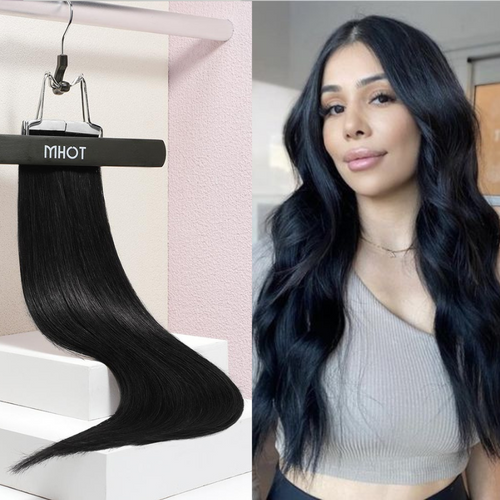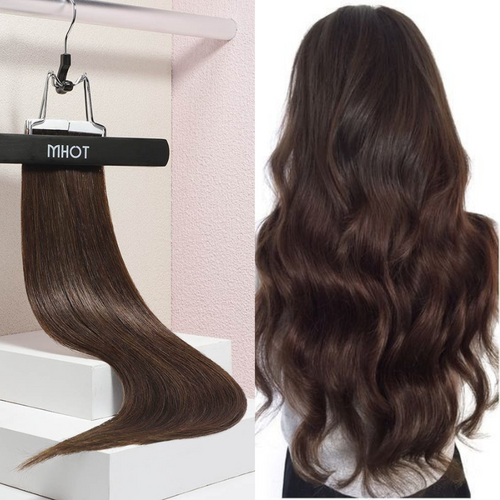I. Introduction
Tape-in hair extensions have revolutionized the world of hair styling, offering a semi-permanent solution for those seeking added length, volume, or thickness to their natural hair. Unlike traditional clip-in extensions, which can be easily attached and removed at home, tape-in extensions are applied using a special adhesive that provides a more long-lasting hold. In this comprehensive guide, we'll delve into the intricacies of tape-in extensions, exploring everything from their application process to their maintenance and removal.
II. Tape-In Hair Extensions: An Overview
Tape-in hair extensions consist of thin wefts of hair that are pre-taped with a medical-grade adhesive. These wefts are then sandwiched between small sections of natural hair, creating a seamless blend that looks and feels incredibly natural. One of the main advantages of tape-in extensions is their ability to lie flat against the scalp, making them virtually undetectable even in thin or fine hair. Unlike other types of extensions, which may require heat or chemicals for application, tape-in extensions offer a quick and easy way to achieve a fuller, more voluminous look without causing damage to the natural hair.

III. Understanding the Adhesive
The adhesive used in tape-in extensions is a crucial component of the application process. It is specially formulated to provide a strong and secure bond between the extension wefts and the natural hair, ensuring that the extensions stay in place for an extended period. The adhesive is typically made from medical-grade materials that are safe for use on the scalp and hair. It works by creating a flexible yet durable bond that withstands daily wear and tear without causing damage to the natural hair.
When selecting a tape-in extension adhesive, it's essential to consider factors such as the strength of the bond, the ease of application, and the compatibility with different hair types. Some adhesives are designed for single-use applications, while others can be reapplied multiple times with proper care and maintenance. It's also important to follow the manufacturer's instructions for application and removal to ensure the best results and minimize the risk of damage to the natural hair.
IV. Pre-Application Preparations
Before applying tape-in extensions, it's essential to prepare the natural hair to ensure a secure and long-lasting bond. This process typically involves washing and drying the hair thoroughly to remove any dirt, oil, or styling products that may interfere with the adhesive. It's also important to conduct a thorough hair assessment and consultation to determine the appropriate length, color, and texture of the extensions for a seamless blend with the natural hair.

During the consultation, a trained stylist will assess the client's hair type, texture, and color to recommend the most suitable tape-in extension options. They will also discuss the desired look and style with the client to ensure their satisfaction with the final result. Once the extensions have been selected, the stylist will prepare the natural hair by sectioning it into small, manageable sections and applying a protective barrier to the scalp to prevent any potential irritation from the adhesive.
V. Application Process
The application process for tape-in extensions is relatively straightforward but requires precision and attention to detail to achieve optimal results. It typically begins with the stylist selecting a small section of natural hair and removing the protective backing from the adhesive strip on the extension weft. The weft is then carefully placed underneath the natural hair, close to the scalp, and pressed firmly into place to create a secure bond.
Once the extension weft is in position, the stylist will use a specialized tool to press the adhesive strip firmly against the natural hair, ensuring a strong and seamless bond. This process is repeated across the entire head, with each extension weft strategically placed to achieve the desired length, volume, and thickness. Once all the extensions are in place, the stylist will blend the natural and extension hair together using various cutting and styling techniques to create a seamless and natural-looking finish.
VI. Living with Tape-In Extensions
Living with tape-in extensions requires some adjustments to your daily hair care routine to ensure they stay looking their best for as long as possible. While tape-in extensions are designed to withstand regular washing, styling, and heat exposure, it's essential to use gentle, sulfate-free shampoos and conditioners to prevent damage to the adhesive bond. Avoiding excessive heat styling and over-manipulation of the extensions can also help prolong their lifespan and prevent premature shedding or slippage.
In addition to regular shampooing and conditioning, it's essential to use specialized extension-friendly products to maintain the health and integrity of the extensions. These products are formulated to nourish and protect the hair without causing buildup or residue that can weaken the adhesive bond. It's also important to avoid using oil-based or silicone-based products near the adhesive bond, as these can cause the extensions to slip or become dislodged.

VII. Removal Process
The removal process for tape-in extensions is relatively simple but should be performed by a trained professional to minimize the risk of damage to the natural hair. It typically involves applying a specially formulated adhesive remover to the extension wefts to break down the bond and gently slide the extensions out of the hair. Once the extensions have been removed, any remaining adhesive residue is carefully cleansed from the natural hair using a clarifying shampoo and conditioner.
After the extensions have been removed, it's essential to give the natural hair a break and allow it to recover from the extension wear. This may involve deep conditioning treatments, trims, or other hair care rituals to restore its health and vitality. With proper care and maintenance, the natural hair will bounce back to its original state, ready for a new set of extensions or a fresh style.
VIII. Benefits and Considerations
Tape-in extensions offer numerous benefits, including their semi-permanent nature, ease of application, and natural appearance. They are an excellent option for those looking to add length, volume, or thickness to their natural hair without the commitment of permanent extensions. However, it's essential to consider factors such as the cost, maintenance requirements, and potential for damage to the natural hair before investing in tape-in extensions.
One of the main advantages of tape-in extensions is their versatility and ease of styling. They can be curled, straightened, or styled just like natural hair, allowing for endless possibilities when it comes to creating different looks and styles. Additionally, tape-in extensions require minimal maintenance and can last for several weeks with proper care and upkeep.
However, it's important to be aware of the potential drawbacks of tape-in extensions, including the risk of damage to the natural hair from improper application or removal. Additionally, tape-in extensions can be more expensive than other types of extensions, and the cost can add up over time, especially if they need to be replaced frequently. It's also essential to consider the impact of tape-in extensions on the health and integrity of the natural hair, as excessive wear or tension can lead to breakage or thinning over time.
IX. Frequently Asked Questions
-
Are tape-in extensions suitable for all hair types?
- Tape-in extensions are suitable for most hair types, including straight, wavy, and curly hair. However, they may not be suitable for very fine or fragile hair, as the weight of the extensions can cause breakage or damage.
-
How long do tape-in extensions last?
- Tape-in extensions typically last for 6-8 weeks before they need to be removed and reinstalled. However, with proper care and maintenance, they can last for up to 3 months or longer.
-
Can I wash and style my hair with tape-in extensions?
- Yes, you can wash and style your hair as usual with tape-in extensions. However, it's essential to use gentle, sulfate-free products and avoid excessive heat styling to prevent damage to the extensions.
-
Can I swim or exercise with tape-in extensions?
- Yes, you can swim and exercise with tape-in extensions, but it's essential to rinse your hair thoroughly after swimming and avoid excessive sweating to prevent the adhesive from loosening.
X. Conclusion
Tape-in extensions offer a semi-permanent solution for those looking to enhance their natural hair with added length, volume, or thickness. With proper care and maintenance, they can provide a seamless and natural-looking finish that lasts for several weeks or even months. By understanding the adhesive bonding process, following a regular maintenance routine, and being aware of the potential benefits and considerations, you can enjoy the versatility and beauty of tape-in extensions while preserving the health and integrity of your natural hair.


